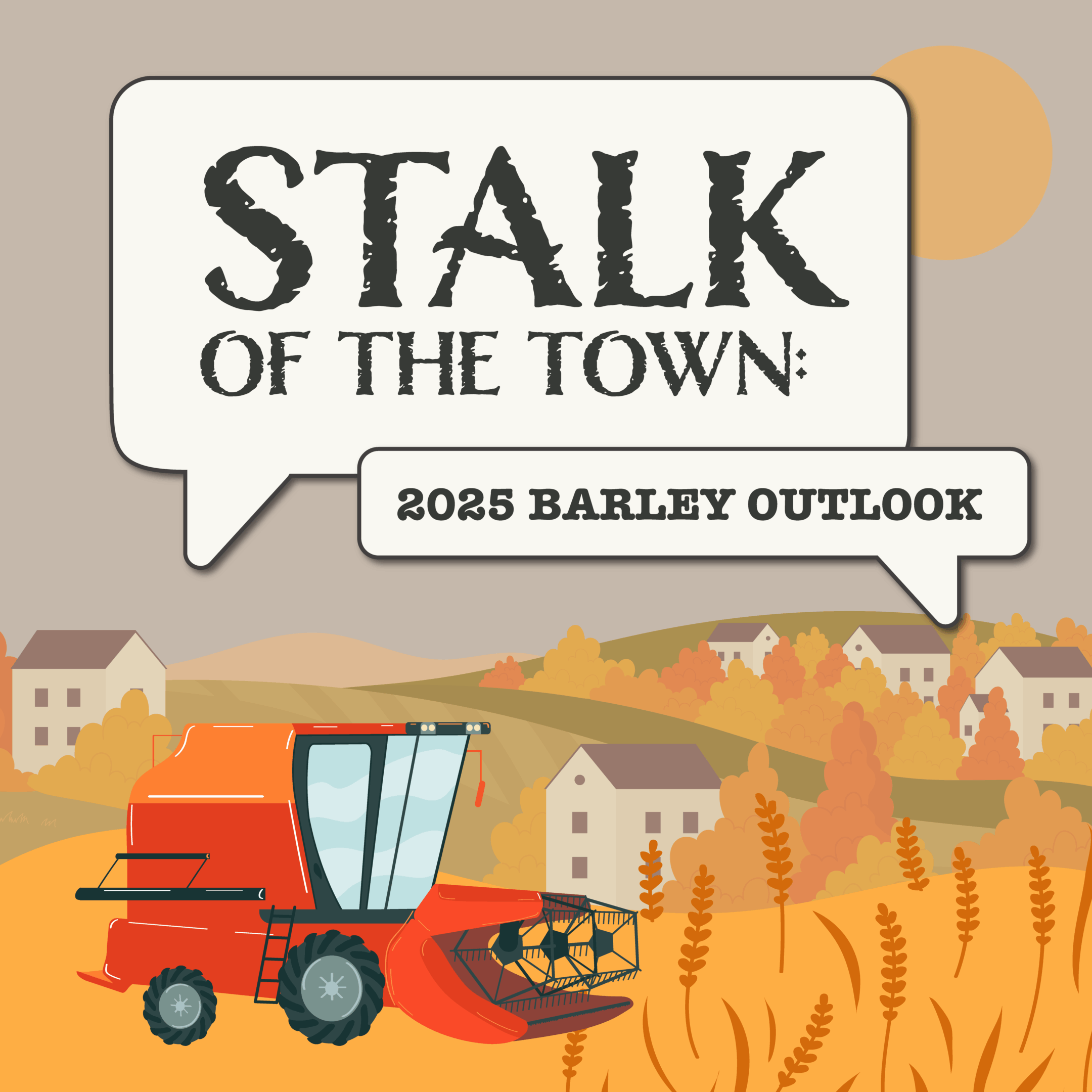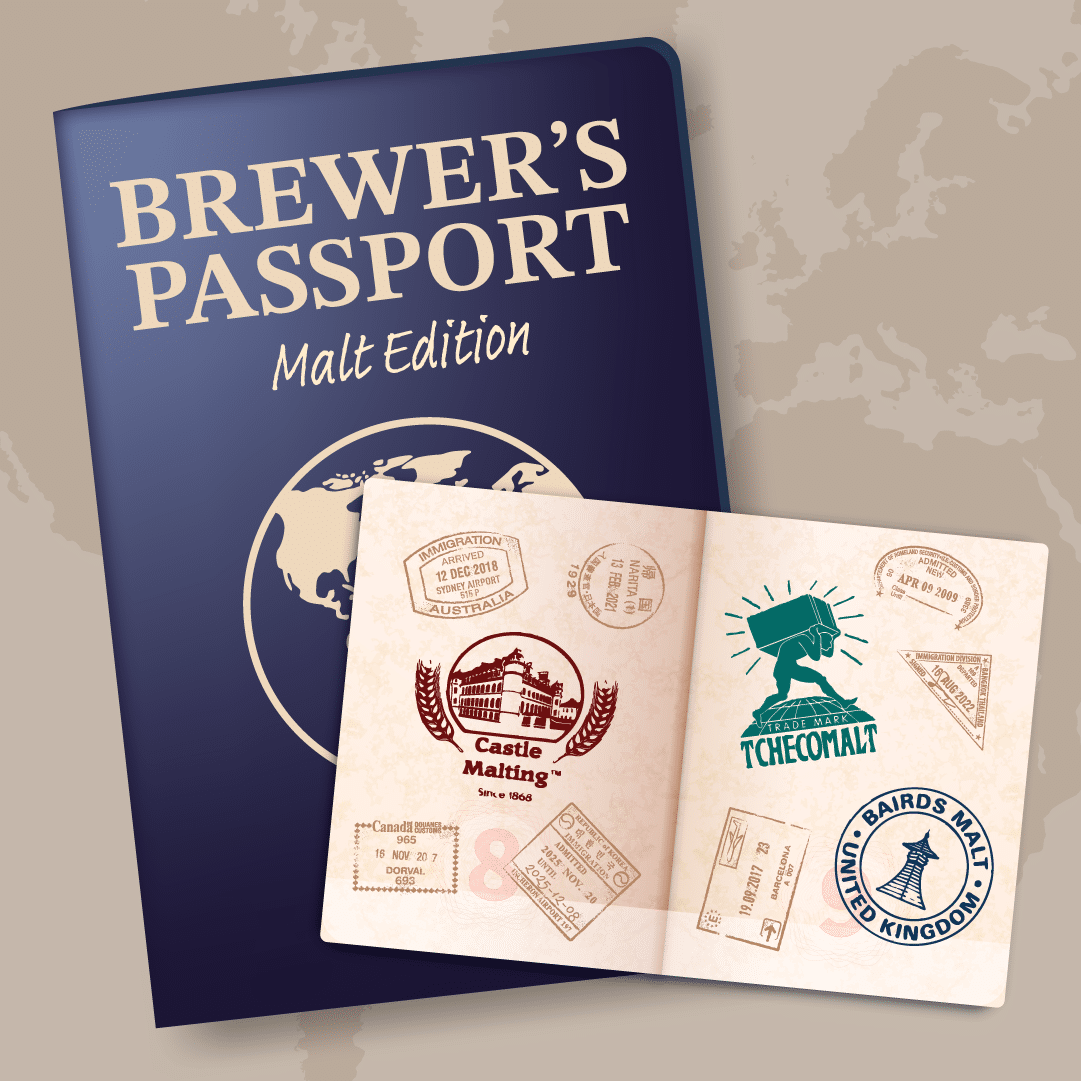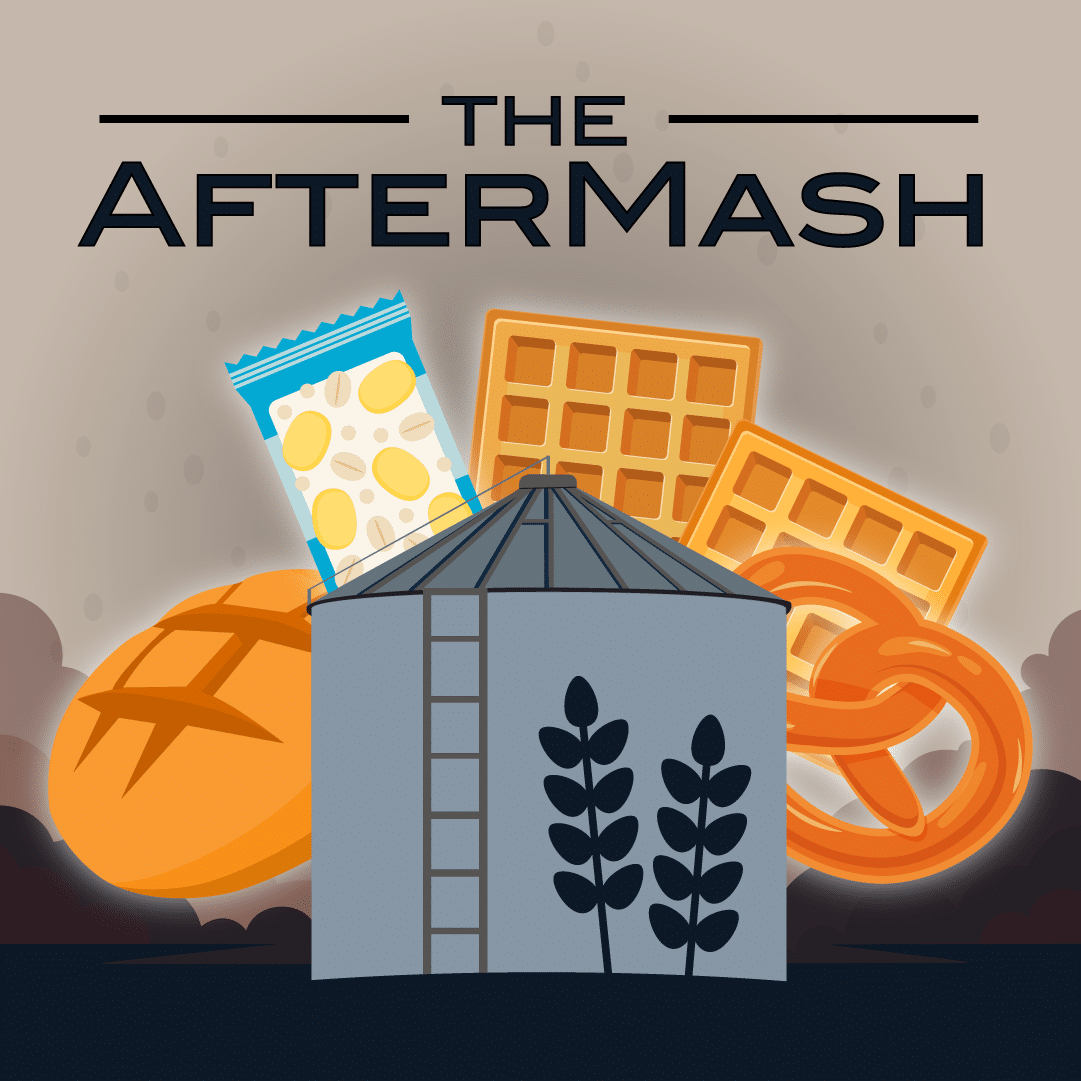
PODCAST GUESTS
Eddie Douglas

In 2012 Eddie was appointed to the role of Commercial Director, responsible for UK barley procurement strategy covering the supply of ~320,000 tonnes annually plus their malt sales strategy covering domestic & export sales markets of some 250,000 tonnes of malt annually.
Over the last 20yrs, Eddie has been heavily involved in building Bairds Malt supply chain relationships through collaborative work with each of their supply chain partners. Bairds approach is that they are working with 5 craft professionals along each stage of the supply route for initial variety selection through to the delivery of quality malt to our brewing or distilling customer
Bryce Parsons

Parsons shifted his scientific focus to flavor studies. To show how many different flavor permutations a spirit can have, Parsons created a different gin every week for a year to ultimately showcase 52 different gins.
He’s done some super cool stuff with whiskey, too. In this episode, listen to the story of how the forest fires contributed flavor and aroma to his whiskey.
Episode Links
SEASON 2, EPISODE 4: TURNING RAIN INTO WHISKY AND BEER
PODCAST HOST:
TOBY TUCKER – DIRECTOR OF SALES, COUNTRY MALT GROUP
GUESTS:
EDDIE DOUGLAS – COMMERCIAL DIRECTOR, BAIRDS MALT
BRYCE PARSONS – HEAD OF DISTILLING OPERATIONS, LAST BEST BREWING AND DISTILLING
Key Points From This Episode:
- Introducing today’s guest, Eddie Douglas.
- Eddie tells us about Baird’s place in the Scottish whiskey industry.
- Hear about the new Sassy varietal and what makes it “Malt 2.0.”
- How Malt 2.0 meets the needs of next-generation brewers.
- Eddie tells us about Golden Promise and how it maintains quality.
- Hear about the history behind Bairds Malt.
- Rolodex roulette leads Toby and Eddie to a discussion with Bryce Parsons, the master distiller at Last Best Brewing & Distilling.
- Creating 52 gins in 52 weeks over a year for the Guinness Book of Work Records.
- Bryce talks about The Beast whiskey produced with peated malt from Bairds, which was surrounded by the Fort McMurray wildfire of 2016.
- Bryce’s advice for choosing fermentables, specifically barley for distilling.
Transcript - Turning Rain into Whisky and Beer
EPISODE S.2, E.4
[TURNING RAIN INTO WHISKY AND BEER]
[00:00:00] TT: Well, hello again to our listeners, and thanks for joining us on another episode of The Brewdeck podcast. I’m your host, Toby Tucker. A big thanks for the continued support of our listeners that lend us, a bent ear, if you will every few minutes every month. If you like it, just keep checking in with us on future episodes by subscribing via your favorite podcast delivery portal.
Today we have Eddie Douglas. Yeah, true Scotsman and commercial director for Bairds Malt Bairds has five malt houses in the UK. And Eddie himself is at the malting, near Edinburgh, Scotland. He’s made it his life’s work to do his part to make sure that the world has enough whiskey. So, I think everybody owes him a high five. And of note, Baird supplies, the top eight Scottish distilleries, and is the number one supplier of the world’s leading whiskey producers. So, super excited to have my buddy Eddie on today. How you doing Eddie?
[00:00:00] ED: Hi, Toby. Yes, we’re the largest malt supplier to the Scotch whisky industry. And it’s all about green quality, malt quality, and consistency for that specific job. So, as such, we’ve got extensive programs that start with the seed breeder through to seed specialists, our agronomists and then our network of malt and barley growers right across the UK that utilize these varieties. And we’re continuously exploring the seed replications to look for varieties that we believe will support the industry for the next 5 to 10 years.
[00:00:45] TT: Yeah, Eddie, I’m super glad you mentioned that because that’s a good segue of kind of why we have you on today, to specifically talk about kind of some news for the listeners on a couple of new varietals or specifically, let’s start with this new barley varietal that we have coming from you guys that we’re going to launch here in North America. The barley varietal is called Sassy and we just received our first shipments from Barretts here in North America and it’s actually branded as Malt 2.0. So, can you tell us a little bit about what’s known as a KWS Sassy varietal and how it came to be so highly desirable barley for malting?
[00:02:25] ED: Yeah, KWS Sassy, came through our demonstration plots that we have here in Scotland. Each year, we’re running about 25, spring varietals, 2 or 3 controls, and 20 to 25 new lines that have potential to meet sectors of the market. And that’s where we identified Sassy as a very good variety to handle the Scottish climate, which can be a challenge at times. And I know you’ve had very challenging times in Texas, they’re just there recently. But we selected or we identified Sassy hop potential there, on farm, on the agronomic performance of the variety. We then secured five returns across the nucleus over a dedicated malt and barley growers, then we converted that to the initial trial, commercial trial on a macro scale.
So, that was year one, that went pretty successfully. We moved up to about 5,000 tons of barley production the following crop year. And that allowed us to do wider scale trials with growers right across the length and depth of Scotland, and also to trial that with a number of end users, and that was the activity loaders to get the variety from a potential variety to a fully approved variety for distilled use. That was in year two.
For year three, now it’s starting to spread. We’re getting an additional Sassy growing. It’s very well received on farm. Farmers like the variety, how it performs, big, bold, good agronomic yield, on a plump kernel and it can handle a bit over what we call a weather challenge across here. So, as the crop comes to harvest, if we have two or three days precipitation, it doesn’t really spoil the quality of the variety, it maintains its quality and comes out the other side. So, from a test variety, three years ago, it’s no probably the variety of choice across Scotland for distillers and something craft brewers are switching into the variety away from some of the more traditional.
[00:05:05] TT: Well, we’re super excited to have it here for our North American brewers and distillers, that’s for sure. You mentioned kind of agronomic yield. So, back a bit, you guys have relationships with 800 plus growers. I mean, you guys have been around a long time. And actually, established those relationships with those growers. Was there a specific option or how did you kind of talk to these farmers to get them to trial, this particular barley in their fields?
[00:05:34] ED: Yeah, I mean, we’ve got a nucleus grower right about each of our malt houses within a 50-mile radius. What we’ve got is our specialist malt and barley growers, and the knowledge of how to grow the best varieties in their microclimate, that’s handed down from generation to generation. So, grandfather, father, son, some of these growers have been supplying our malt house for the last 40 years. So, they are known in the area as highly specialist malt and barley growers. And they are very, very keen to explore new opportunities and innovation within the varietals.
So, when we have the opportunity to select some of these new varieties from the seed breeders, we are doing our own private trial plots. If they show potential there, to our variety committee, which is all in-house, we are controlling from the day the seed grows in the ground, to the samples being [inaudible 00:06:47] is done on beer’s malt laboratories, the data is exact. And it’s with confidence we can go forward and suggest to some of these dedicated malt and barley growers that they can put a percentage of the area into your new trial variety. And it’s all about them being there and seeing the next generation of varieties coming through that will sustain the market for their products.
[00:07:17] TT: Sure, and they’re also, they’ve got to make a living out there, right? They only have so much ground and there’s a lot of different barley and other crops they put in the ground. It’s got to have a return, right?
[00:07:28] ED: Yeah, barley and wheat is competing for that area. So, malt and barley is a good crop, good paying crop, as long as you have the quality. As soon as you lose that quality, your return will be totally diminished. So, they are very keen to see not only ergonomic yield, but the quality and consistency of a variety to ensure that what they put under the ground as malt and barley actually makes it through the full process and doesn’t then be re-graded as a lower grade feed bottle.
[00:08:04] TT: I’ve got a bag here and listeners can probably hear it, but I’m looking at a sample that was sent to me. This Sassy, bagged as Bairds Malt 2.0, is huge. It’s very, very plump.
[00:08:16] ED: Very plump, yes. And that’s on the back. One is a varietal and two is the growing season and Scotland. We’ve got a long cool growing season. So, the further north you come, we move from 130 to 104 day crop cycle. In the heart of England through to northeast Scotland that could be 150, 160 crop cycles, so it’s a long cool growing season. So, not only promotes lower protein, but gives you that big bold kernel. It’s daylight hours that’s doing the work and rather no temperature. There’s no need to irrigate crops, Mother Nature looks after that for us in the UK here in spring.
[00:09:07] TT: You know it’s really cool, Eddie, that you guys, being that the heritage of Bairds Malt, particularly in Scotland, dates back to, let’s say, 1823, that you guys are continuing to be innovative, and this particular barley varietal is one way that you guys are doing that. Now, how does outside of Sassy and some of these new barley varieties, how does this particular Bairds Malt 2.0 meet the needs of kind of the next generation distillers and modern-day brewers compared to some of the other malts in the portfolio?
[00:09:38] ED: Yeah, we’ve touched on it there. That big plump kernel gives you an excellent extract levels. It’s very robust and predictable on its protein levels too, so if it’s grown on a specific program for low protein for distilling, say 8 to 8.5, it can consistently hit those numbers. And some of the growers that are aiming for brewing and 10.5 to 11 can go forward with confidence that they can hit these levels year in, year out.
So, it’s that consistency. I mean if we go back, there’s another varietal that we are bringing out across to consumer group is Golden Promise. And that was the variety that really kicked off malt and barley growing in Scotland. It was always presumed that Scotland was too hostile in environment, it was too late and maturity, it would never really be able to produce malt and barley. But in the mid ‘60s, Golden Promise came forward as a variety, malting variety. And it was the first one that proved that Scottish growers could actually produce malt and barley.
So, the Sassy is a modern-day equivalent, I would say. It’s very robust and well suited to that cooler, longer growing season. It will give you good extra level, excellent flavors, and you will see enhanced mouthfeel and linger certainly when you’re talking about unique spirit coming through for this.
[00:11:30] TT: We were lucky enough to get some bags of the Malt 2.0 and the Golden Promise stateside a couple of months ago. And we did have some folks do some trials of it, and you’re right, just very high extract beautiful end results on both the 2.0 which is the Sassy barley varietal, and the Golden Promise, which Golden Promise has been around for what, 50 years or so? So, it is kind of a heritage variety. Yes.
[00:11:57] ED: Golden Promise is definitely the heritage variety. It’s grown on specific farms with generational growers that understand the variety. And probably that knowledge of how best to grow that variety varietal on farm is being handed down from grandfather, father, and now, son is running a variety. But out of about a million tons of malt and barley produced in Scotland, we’re talking about Golden Promise would be a few thousand, maybe 10,000 to 12,000 tons per annum is actually – to put in context, the super specialist.
[00:12:42] TT: Sure, absolutely. Let’s talk a little bit more, Eddie, about kind of the heritage. You mentioned about you know some of the growers that are in the Bairds network have been growing generationally, if you will, for quite some time providing a barley to Bairds for malting. Can you talk a little bit about the Bairds history for the listeners that don’t know?
[00:13:02] ED: Yeah, I mean, Bairds started off, as you said, 1823, two brothers, here in Montague and Glasgow, and they had the great Canal Brewery. So, they were actually brewers and maltsters. And it was huge that identified that really produce consistent beers, all have to start with the raw material. So, Hughes spun away and he really focused on the malting side of the business. And from the initial malt house, they had their Grand Canal. They started to produce further malts and other floor maltings that then they could market to fellow brewers and make sure they enjoyed the consistency of malt supply and raise the standard of brewing under final products.
You look forward, their sons then came along into the business and from the initial brewing malt house brewery, malt house in Glasgow, they ended up with three malt houses, two in Glasgow, one in Greenwich in London. And from there, it really took off. Around and about, they realized that where there was a large population centers, they really needed to have floor maltings, if there was good barley supply potential within that region. So, within the Glasgow, servicing a lot of the Glasgow industrial consumption, and then Greenwich covering off London obviously.
And then the heyday of floor maltings before we’ve seen pneumatic moldings come in the mid ‘60s, Bairds Malt actually peaked around over 50 floor maltings across the UK. Some of them fairly small, but really focusing on the fact that there was quality malt and barley supply in that locality. So, they would set up floor maltings to convert that locally and offer it to the brewers within that region. It was really in the ‘60s that Bairds Malt ended up consolidating a lot of the floor maltings into pneumatic maltings and that’s where the [inaudible 00:15:29] site and assets came along, followed by the site and outskirts of [inaudible 00:15:36] was one of the first pneumatic maltings in Scotland in 1964. And then, it remained with those two primary production units for about 30 years. And then when Bairds got back to the idea that they really needed to have malting facilities as close to the quality malt and barley supply. Thus, the manager that brought us up to five malt houses in the UK. We’ve got Inverness site in the north of Scotland, picking up the quality of barley in that area.
We’ve got the Ouroboros site, just south of Dundee, catching a lot of the quality barley along that coastal area there and then the Caitlin site picking up a lot of the quality of malt and barley in the lowland and borders. Grantham site in Lincolnshire, and in West Ham site and Essex. And if you look at a map of the UK, is all along the eastern seaboard. That’s a high-quality malti and barley ground. There’s not a lot of malt and barley would be growing the west of Scotland. So, on the East Coast strip, and you can see there, it’s that’s where the malting sites tend to be navigating and securing their supply year on year.
[00:17:04] TT: Yeah, definitely a long, long line of history there. And we’re very happy and obviously, super thrilled that we were able to help get the Bairds malting products into the hands of North American brewers and distillers. And, Eddie, we’re very excited about the KWS Sassy varietal, which again is branded through Country Malt Group is Bairds Malt 2.0. And then obviously, the Golden Promise is something that we’re very excited about as well.
[00:17:32] ED: The Malt 2.0, we see that as a next generation malt varietal. And it’s been well, well received in the UK and we’ll be excited to hear the feedback from stateside on Saturday.
[00:17:38] TT: Yeah, absolutely. Well, it’s new innovations like these coming from Bairds that you guys are building upon the maltster’s foundations of tradition, if you will. Not to replace the structure, but to bring new and exciting malt to help brewers and distillers reach their full potential. And these are just two, I would say, Golden Promise is not a new product, but it is here to North America from Bairds. So, really excited about it. And we do have samples at Country Malt Group for those listeners, brewers, distillers that want to get their hands on some and give it a try. I would absolutely love to hear from you, reach out to your territory manager or sales representative for Country Malt Group and we certainly will get some out in your hands.
Eddie, I appreciate your time. It’s always a wonderful opportunity to speak. Anything else in closing for the listeners?
[00:18:37] ED: My closing statement would be that, I know there are some excellent beers and spirits being produced stateside. But to trial Malt 2.0 in that product, I think you could be very well surprised that it has the potential to take excellent beers and spirits to the exceptional level. Basically, it’s a real step change, I would say on what we’ve seen in the last 10 to 20 years on malt quality and the potential that can bring to your products.
[00:17:30] TT: Yeah, absolutely. It’s fantastic what you guys are doing out there, Eddie. We’re glad to be able to represent Bairds here in North America. I really appreciate your time, Eddie. We’re going to do some little fun here. Actually, obviously just wrapped up some business, so what do you say we just relax a little bit and have some fun in a segment we call The Whirlpool? The water here is toasty in the whirlpool. It’s about a 102. The jets are pumping, so let’s jump in.
[THE WHIRLPOOL]
First question, Eddie, what do you call a whirlpool over there? We call it a hot tub, whirlpool.
[00:18:06] ED: We’d be in the hot tub side of the game, I would say. [Inaudible 00:02:47] it would be.
[00:18:14] TT: There we go. Well, it sounds good about right now, so we’ll have a little bit of fun. In this segment of The Whirlpool, I’m going to do something interesting here. We’re going to play a little bit of a rolodex roulette with my contacts on my phone. Basically, what I’m going to do is just going to spin the wheel here and see who it lands on and give him a call. Let me spin the wheel here on my phone, see what pops up.
All right, mother-in-law. I love the mother-in-law. It’d be interesting to chat with her, but probably not good for the subject matter. Let’s go to the next one. Lands on the p’s. Parole Officer wait a second, I don’t have one. Pest control. Let’s see, try one more time here. Ted Johnson. Yeah, I don’t know who Ted Johnson is. Hey, do you ever get that? You ever scroll through your contacts and realize there’s somebody in there you have no idea who they are?
[00:19:15] ED: You put in there in good faith and possibly sober. If not, got a few in the bar. It’s like, “Yeah, I’ll call you.”
[00:19:25] TT: Yeah, I think Ted’s one of those. I’ll have to give him a shout and see. It’s wild, you and I being in sales, it’s not really good to not remember who our contacts are. All right, Bryce Parsons. Oh, that’s cool. This is interesting. Yeah. Bryce is the master distiller and operations manager at Last Best Brewing and Distilling in Calgary, Alberta. This is cool. Eddie let’s get him on the phone here.
[00:20:02] ED: Yeah, it would be cool.
[00:20:03] TT: Yeah. Actually, I think you guys know each other. I haven’t talked to Bryce –
[00:20:08] ED: We‘ve spent quite a bit of time across in Canada. Bryce and Spike came in and visited Scotland in early 2017. Yeah.
[00:20:19] TT: I haven’t talked to him in probably, four or five years. Let’s give him a shout, and hopefully he won’t hang up on me. Bryce, can you hear me? Toby Tucker. Country Malt Group.
[00:20:38] BP: What’s up, Toby?
[00:20:40] TT: Do you have a minute?
[00:20:41] BP: I do. Yeah. I’m just on the road right now.
[00:20:44] TT: Man, I am super stoked. I got to hold you. Don’t hang up on me. We haven’t talked in a long time. You’re obviously driving, so you’re not drinking right now? My first question was, what are you drinking right now, but let’s hope there’s nothing in your hand. Okay. When you get where you’re settled this evening, what will you be drinking?
[00:21:01] BP: Well, I’m going up to Banff, I’m going out to our brew pub there. I’ll probably settle in with their black pilsner out there.
[00:21:10] TT: Second question, have you ever been arrested?
[00:21:12] BP: Have I ever been arrested? Not that I know of. I haven’t been arrested. Not yet. Trying to avoid that.
[00:21:18] TT: All right, another odd question for you. Definitely, I missed, during the old COVID stuff, I found several different varieties available when I had to buy some. Favorite brand of toilet paper?
[00:21:31] BP: During this COVID thing, I think I’ve been down with the Costco brand, the Kirkland brand toilet paper.
[00:21:39] TT: How’s that treating you?
[00:21:41] BP: That’s the favorite. You know what? I did buy, in the time of the whole panic of March and April, I did buy one of those Toto Japanese toilet seats. I don’t know. I might not need toilet paper next shutdown.
[00:21:58] TT: Man, I’ve heard of people using those things.
[00:22:00] BP: They’re incredible.
[00:22:02] TT: That’s awesome. All right. Have you ever heard of the Guinness Book of World Records?
[00:22:06] BP: I have. I have.
[00:22:08] TT: Is it true that you are in it?
[00:22:11] BP: Not officially yet.
[00:22:12] TT: Okay, well, more to come on that. Last question. Favorite UK malt supplier whose name rhymes with Letty Mugless.
[00:22:20] BP: Letty Mugless. Oh, that was the legendary Eddie Douglas with Bairds.
[00:22:25] TT: You got it. The legendary Eddie Douglas. I got him with me on the phone, man.
[00:22:30] BP: Awesome. Hi, Eddie. How are you?
[00:22:31] ED: Very well. Thanks. Yourself?
[00:22:32] BP: Oh, I’m doing good. Just early Friday morning for me, heading out to Banff to spend the day in the mountains. Maybe the night, if I’ve had to find too many black pils.
[00:22:42] ED: Oh, yeah. I remember that road well. Yeah, we’re just heading towards 5 p.m. here in the UK, so I’ll beat you to the bar, I think.
[00:22:52] TT: There you go. Man, this is cool. I could get you guys together. From what I know, Bryce, you spent some time actually with Eddie, touring around out in some of the distilleries out there. I know you’ve got a real rich history, Bryce in distilling. I think you spent some time getting educated out there, right?
[00:23:11] BP: Yeah. I attended Harriet Watt. Probably, I think it was around 2010, and did the masters in brewing and distilling out there. Loved absolutely every minute of it. Made so many contacts. So many friends all around the world. It was definitely, so far a highlight of my life.
[00:23:30] TT: In your time you spent with Eddie, is there a story, or something you can remember that is age appropriate that comes to mind in the time you spent with him out there?
[00:23:41] BP: Yeah, yeah. Well, the whole time was absolutely fantastic. It was a bit of a whirlwind over, I think, about three or four days, because we started at Edinburgh and headed up all the way up to Inverness to see the maltings up there and did a big loop. Then down to Glasgow and then caught a plane to Islay. I think, one highlighter, you’re touring around with this guy and all of a sudden, you’re on an island, so we flew to Islay, so we take a plane over there. In the meantime, he’s telling you the whole time that the flight sometimes it gets canceled, sometimes or frequently gets cancelled and you’re having to put a lot of faith into this guy.
Then so we’re on the island and then all of a sudden, we’re driving around and then he wants to go this other island. He wanted to show us Jura. To get to Jura, you go and you take this little rickety Ferry over, that if I was just driving around, I would even think it was a ferry or whatever. I think you have to pay cash. It seemed pretty dodgy. At the same time, you’re like, “Well, I’m going over this island. How if I get stuck here?” I’m already on an island that, frequently, the flights get cancelled due to weather. Then I’m going to this other island.
I think it was just that, what made it stick out was just putting faith into this guy, and as he took you in the middle of nowhere. It was absolutely incredible. Jura, it was no other landscape I’d ever been in my life. Especially in Canada, I’ve been in lots of places in Canada and there’s lots of different landscapes, but that was something special, along with the great whiskey at Jura Distillery.
[00:25:31] TT: Absolutely. Eddie, is that how you remember it?
[00:25:33] ED: Yeah. A single road in Jura. It is a bit of a tricky ferry. It almost goes across side on, because they come there is massive. On Jura, believe it or not, wild deer outnumber the population five to one.
[00:25:50] TT: Was that bear? Wild bear?
[00:25:51] ED: Deer.
[00:25:52] TT: Oh, deer. Okay.
[00:25:54] ED: There’s a single road that leads from the island and it takes you to the distillery. That’s the only road that is on the island.
[00:26:03] TT: It sounds like any folks we send out there, from now forward, we need to have them sign a release form, or something, putting them on little dinghies out there, trying to cross water, bodies of water, Eddie.
[00:26:14] ED: You’re rewarded for the effort. I can highly recommend anybody, anyone that makes the trip to Islay doesn’t take Jura has missed the trip, basically.
[00:26:27] TT: Yeah. Well, Bryce, what’d you learn from your experience that you brought back home to what you’re doing now, as far as the distilling side of your business?
[00:26:34] BP: I think the biggest thing is especially since I was educated there and with Harriet Watt, a lot of the focus is malt whiskey production. I think what I took – it was just learning the stories of a bunch of the established brands and how they got to be where they are and the people behind them and just the real passion and how they’re looking at ways to connect in their area.
If you look at Bruichladdich, for example, here you have a distillery that was mothballed, restarted, a little bit on a shoestring budget. It was one person hired and then another person hired. A big part of their whole measurement of success is job creation for people on the island. I think, and finding different ways to help incorporate that, fold that into their story, they’re making malt whiskey, like numerous other. I think there’s what, over a 100 malt whiskey distilleries in Scotland. They were doing things, extra things to fold into their story to make them stand out. I think it was taking a lot of the tidbits there that was quite phenomenal.
[00:27:46] TT: Absolutely. I know you’ve worked with a lot of different products on both the brewing and distilling side. I know that you’ve had a heavy focus on at some point and are very passionate about gin, which goes back to my original question about the Guinness Book of World Records thing. I know last time we hung out, you were in the process of actually creating 52 gins over 52 weeks, is that right?
[00:28:15] BP: Yeah, that’s right. It was a gin a week, so over a year. Yeah, that would be 2018 now. I took on that task of doing it and created a project for a couple things. A, it was a challenge to myself. B, it was um a way to engage the community and stakeholders in the community, because part of the project was incorporating different bars, different restaurants, bartenders, chefs, retailers, charity organizations.
Because gin, I think everyone knows by now, gin’s really blowing up the last couple years. Everyone’s really, really focusing on, or being engaged with how creative that spirit category can get. Me being a very creative person myself, it just made sense to well, why don’t we just do 52 in a year? To me, that was a natural thought. Some people, maybe not.
There were some challenges with it, but it was very rewarding overall. What we’ve taken out of that now is actually, part of what I’m doing right now, is that we’ve we focus on scaling up our gin production, since this whole COVID thing happened all over the world. I’ve actually taken two of the gins from that series and scaled them up and now we’re releasing them on a larger – to a larger audience now.
[00:29:55] TT: The Guinness Book of World Records thing, is that just being looked into, or just curious?
[00:30:02] BP: When you apply for it, of course, they look into it and they need references. Then they basically play it like, “Okay, well, we’re researching it.” You have to keep checking in on it, because they just research it and research it, until they come to a point where they’re convinced that that’s what it is. You pitch the idea that, “Okay. This is what I’ve done.” They’re like, “Yeah. That could be a record,” or “No, it can’t.” Then once they say yeah, they go in and they start looking at it. Yeah.
[00:30:36] TT: Yeah. Records or not, it’s pretty awesome. I’ve never had the chance to try one of your gins that you were doing out at that time. It’s pretty, pretty cool. Yeah, it seems like a lot of work, but really, really cool.
Other than gin, last time talking about, obviously, getting in and laying down some whiskeys and probably been skirted a little bit on that side of the production. Is there something currently you have laid down and you’re excited about, as far as the whiskey side?
[00:31:07] BP: Well, yeah. There’s a couple things. We’ve been doing whiskey for about five or six years. Yes, six years now. April 2014 is when we laid down the first – it was a half barrel and then we just increased our production every year. However right now, we’ve put it on pause with COVID, because our company to anyone listening, we started out as a brew pub company.
We have four brew pubs around the province of Alberta. Then the distillery out of Calgary. We have lots of things going on in our company. This thing has really affected obviously, bars and restaurants. We actually had to close all four, lay off 300 and some people. Then that’s – we’ve had to re-set and slowly open up everything. All four locations are open up now and we’re slowly planning on making some more whiskey.
My approach this whole time has been, I’ve always been fascinated with specialty malts. I think you’re seeing that more and more with new distillers coming on, trying to find their own profile, or their own distinction. I think now, you could consider us a little bit of an experimental distillery. We have a couple products that we do consistently year over year, but there’s a lot of stuff that we play with.
In general, a couple highlights; I would say, one consistent one that we do is a tri-malt whiskey. I work a lot with Canada Malting, so because they’re in Calgary and then I’m distilling out of Calgary. A lot of our base spirit, we’ve made vodka and we made whiskey out of it, is made out of malt barley, malted wheat, and malted oats, which is unique to have three different grains all malted in a product.
Another one I would say is turning out really well is the one that I think Eddie had a little bit of a hand in was The Beast whiskey that was done in our Fort MacMurray distillery while it was open. We closed it up last year. It was great. With that, that was using – where the tie-in was with Eddie was we were using Bairds’ heavily peated malt and we’re getting it shipped over, obviously, and it was sitting in Fort MacMurray which is in Northern Alberta. They ended up having a forest fire that evacuated over 80,000 people.
That malt got stuck outside, so it’s a valley in Fort MacMurray and it got stuck outside. It was over a month evacuation of the town, it sat in this smoke from the forest fire. When we came back and we’re coming back and we’re throwing out a bunch of stuff, I mentioned – I phoned up there I said, “Don’t throw out that malt. Let’s get it checked out and see if there’s any flavor shift that’s happened, influenced from the forest fire.” That’s where Eddie came in and there’s significant flavor change that you had this dual smoke malt, that you had mint and piney note from the forest, because Fort MacMurray sits in the boreal forest. Then you obviously had the peat smoke as well, which is a different type of smoke.
We decided to make a 100% malt whiskey from it. I was happy. Eddie came up. He came up actually for the distillation of that. I unfortunately couldn’t come, because, and this is a bit relevant to what’s going on in the world today, is I was actually hospitalized at the time with, now in hindsight, I think I had COVID-16 back then, like some earlier iteration of what’s going on around now. Because I couldn’t kick anything and I was in and out of hospital five times.
I just got out of hospital and I was going to jump on a flight and get up to Fort MacMurray and I got to my house and climbed a set of stairs and I couldn’t breathe. I made a call. The head brewer at the time was Spike Baker. I called him and I’m like, “You’re going to have to do the run. Why don’t you grab Eddie to help you with the cut points? I’ll be on the phone and let you know and you just keep reading what the temperature and the alcohol percentage and everything are.” I definitely needed an established palette and that’s where Eddie came in.
[00:36:09] TT: Wearing his kilt?
[00:36:10] BP: Yeah, he was wearing it.
[00:36:13] ED: Eventually. Yeah, they lost my kilt on the way in, actually. The airline lost that bag. I did recover it for this Saturday. We did the Friday evening, which was the distillation and the initial auction. I was kiltless. Thankfully, for the locals, I had a suit with me.
[00:36:32] BP: Yeah, you did wear pants though. You just didn’t wear nothing.
[00:36:38] ED: Yeah. We recovered the kilt and we’d seen the firefighters on the Saturday. Yeah. I mean, it was amazing, the difference on that malt, because I had malt that is typically produced in the Inverness facility and it was, yeah, were traditional smoky bonfire, sweet smoke. When I certainly nosed the malt sample, it was a pine spruce element coming through and there was yeah, a shed load of wild mint in there also.
[00:37:15] TT: Yeah, it’s extremely cool. Bryce, so was that just one-time? Do a laymen like me, any way I can get a hand on some of that stuff?
[00:37:23] BP: Well, yeah. It was a one-time distillation, because put that together, like you A, need the forest fire. We don’t want that to happen again. Yeah, it’s still aging, and barrel is aging beautifully. When it gets released out, yeah, stay tuned and yeah, there’ll be some bottlings available.
[00:37:45] TT: Yeah, that’s really cool. Bryce, is there anything else you’ve been up to, any other projects you’ve been working on you want to chat about?
[00:37:53] BP: The big focus for us right now, and this is probably collective as our leadership team is really navigating and crawling out on what we can do with all the restrictions in place and still the uncertainty that’s in the air. I’m dialed in on gin production right now and getting that out. That’s why I’m going to Banff right now. We’ve launched, the gins at one group July 1st and then we’re going to launch in our other communities. Banff, Jasper, and Edmonton, August 1st. I’m just a week ahead of getting those teams ready to take those on.
[00:38:16] TT: All right. Well, any food for thought, or advice for our listeners on choosing from fermentibles, specifically barley for distilling, and/or how to set their product apart from the masses?
[00:38:29] BP: Yeah, sure. Having something that brings on differentiation to what you typically see in exchange for yield. When I look at that, when you frame it up like that, that really opens up to a lot of the specialty malts that you could get into. I find it incredibly fascinating right now, what’s happening in distilling especially, because you have this, unlike brewing that had, especially in North America, but you had dominant brewing companies that did one style of beer and then you had all the craft brewers come in and start using more hops and exploring all the other styles.
Well, distilling companies, they do – if you’re a whiskey, you do a certain whiskey, but there’s a lot of variety in their portfolios already. I find the smaller guys doing a great job. It started out with just paying ode to tradition. Now I see a shift going to people just really, really experimenting and doing some unique stuff. The people buying this stuff are just always interested in there’s just an appetite to absorb anything that is new and unique.
I see a big opportunity in barley, especially special varieties, specialty variety, or varietals that could add different flavor profiles to what your product is. I use a lot of Munich, for example, because you still get some yield, but then you get some flavor contribution as well. Roasted barley is always great. However, you’re not going to get any yield out of that, but there’s definitely a significant flavor contribution.
You could mimic different barrel flavors that are coming in, just by using different malts. Then also, just getting away from some more traditional malt bills. I went down to Louisville, Kentucky in November and it was great seeing what was happening there. Here, you see a very rich, historical distilling region that focuses obviously on American-style whiskey, or bourbon, so with corn and wheat and rye and a little bit of barley.
Not only a lot of the distilleries are out in the 45 minutes from Louisville and out in the country, but now they have this big urban distilling resurgence happening with Angels Envy and Peerless and Rabbit Hole. I started noticing that Rabbit Hole, especially, they have one product that was using a specialty brew, barley variety. I think they were using a honey malt or something in one of theirs.
Then as you look into more of the area, there’s Chattanooga Distillery down in Tennessee. I’ve never been, but I’ve definitely been following them. They actually have coined this term of high-malt whiskey. Versus, in the bourbon world, you’ll have high-rye and low-rye. If you have over 30% of your grain belt rye, then it would be say, high-rye and under 12 would be I think, low-rye. Well, they’re taking out the rye a little bit and adding malts. They’re using up to three different types of specialty malt.
Now that distillers are getting and getting more in tune with what brewers are doing and what brewers have been using, they’re now incorporating that into the fold with what they’re doing because, despite their two very parallel industries, it is actually amazing that there’s a lot of brewers out there that don’t know much about distilling. There’s a lot of distillers that don’t know much about brewing. You’re seeing that now this shared knowledge base is I think, more brewers are going into distilling now as well and they’re bringing some of that knowledge of how they put together their malt or their grain bill recipes in from the craft brewing industry.
[00:42:35] TT: Yeah, you’re absolutely right. We’re seeing those two sides combine a little bit. Eddie, I know with such a deep history there in your neck of the woods. Are you seeing a lot of craft distilleries? Are you seeing a lot of creativeness going on, like we’re seeing here in North America, or there are pretty much just people stuck to the roots there doing the same thing?
[00:42:57] ED: No. There’s been a huge explosion of craft distilleries, on the back of the gin, which is distilled today, and you can sell it tomorrow. That gives them the cash flow. They certainly underpin the business on that basis. Then it allows them to experiment and to stick away some single malts. We are seeing that same thirst for innovation, or some people just trying something new.
They haven’t got the history, or the heritage of the big blue-chip brands, but they have got distilling knowledge, brewing knowledge and they’re looking to carve out a differentiator for their brand. One thing I would say, is that the majority of them follows the mentor that is underpinning the scotch-whiskey industry for the last decade or two is the quality sales. If you were to go to a distiller and offer them some low-cost malt, that doesn’t really ring a bell with a distiller, unless it’s going to bring something unique to his spirit profile.
I often say to new people that’s coming into the business that distillers by malt as if how you would buy your first pair of shoes for your child, as they make their first independent steps in the world. They will buy the best quality they can afford, because putting that into high-quality wood and sticking that in the warehouse gives them ideal, infinite opportunities on that forward curve. Whether that comes in 3, 5, 10, 20 years’ time is irrespective. As long as they’ve got a bit of cash flow, quality spirit, and quality wood, will find a premium at some point.
[00:44:50] TT: Yeah. Absolutely. Well, Bryce. Hey, man. I appreciate you jumping on last notice there and answering the phone and not hanging up on me. I know you got some stuff to do, and you got to get some gin going. I really appreciate your time. Take care. Be safe out there and great speaking with you today.
[00:45:09] BP: Yeah, this is awesome and good surprise here and hearing from Eddie as well.
[00:45:13] ED: Yeah, great to catch up, Bryce. Well, now you’re the new father, you might not be able to just be fruitless and fancy-free to travel about. Certainly, I’m sure we’ll pass, or cross, whether that’s me back in Canada, or yourself bringing Brett and the boys across for a bit of a tour in Scotland. You’re welcome any day.
[00:45:33] BP: Yeah, absolutely. You just got to make it happen.
[00:45:38] TT: Hey, Bryce. For those that want to come see you and get a taste of some of what you’re working on, you guys got some hours of operations you want to share, or when can they come up and try some of your product? Not really?
[00:45:55] BP: Anyone’s welcome any time. Just the complexities is COVID. Yeah, it’s making things tricky.
When everything gets going back going, yeah, we’re open typically seven days a week, 11:00 till 8:00. Last Best in Calgary. Then you could mosey on to Banff Ave Brewing or Jasper Brewing. There’s some great drives and be right in the heart of the Rocky Mountains.
[00:46:22] TT: Awesome. Yeah, I just inadvertently forgot that we had COVID going on. Getting so enthralled in our conversation and getting thirsty. Yeah, it would pose a challenge. All right. Bryce, I appreciate it, man. Have a fantastic rest of the day and we’ll catch up soon.
[00:46:39] BP: Yeah, absolutely.
[00:46:40] ED: Thank you so much.
[00:46:42] TT: See you, man. All right. That’s pretty cool, huh, Eddie?
[00:46:44] ED: Yes, it was a nice surprise there. I do follow him on the Twitter feed and see what they’re up to now and again. These 52 gins was quite an achievement on that one certainly.
[00:47:00] TT: Absolutely. Real good, dude. I know it’s getting extremely late out there for you, Eddie, and it is closing time for you. I really appreciate your time and miss seeing you out here and absolutely, to have a fantastic weekend. Yeah, we’ll chat soon.
I appreciate everybody joining us for this episode on The BrewDeck and we look forward to having you join us on the next one.
[00:47:24] ED: Okay. Have a good weekend and stay safe, everyone.
[00:47:27] TT: Eddie. Thanks so much, buddy.
To all you good folks that managed to spend some time with us today, thank you. And make sure to subscribe so you don’t miss future episodes of The BrewDeck Podcast. Till next time, I’m your host, Toby Tucker.
[END]












